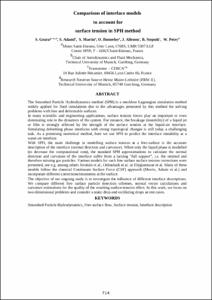Mostra el registre d'ítem simple
Comparison of interface models to account for surface tension in SPH method
| dc.contributor.author | Geara, S. |
| dc.contributor.author | Adami, S. |
| dc.contributor.author | Martin, S. |
| dc.contributor.author | Bonnefoy, O. |
| dc.contributor.author | Allenou, J. |
| dc.contributor.author | Stepnik, B. |
| dc.contributor.author | Petry, W. |
| dc.date.accessioned | 2020-05-08T15:47:09Z |
| dc.date.available | 2020-05-08T15:47:09Z |
| dc.date.issued | 2019 |
| dc.identifier.isbn | 978-84-121101-1-1 |
| dc.identifier.uri | http://hdl.handle.net/2117/186866 |
| dc.description.abstract | The Smoothed Particle Hydrodynamics method (SPH) is a meshfree Lagrangian simulation methodwidely applied for fluid simulations due to the advantages presented by this method for solvingproblems with free and deformable surfaces. In many scientific and engineering applications, surface tension forces play an important or evendominating role in the dynamics of the system. For instance, the breakage (instability) of a liquid jetor film is strongly affected by the strength of the surface tension at the liquid-air interface.Simulating deforming phase interfaces with strong topological changes is still today a challengingtask. As a promising numerical method, here we use SPH to predict the interface instability at awater-air interface.With SPH, the main challenge in modelling surface tension at a free-surface is the accuratedescription of the interface (normal direction and curvature). When only the liquid phase is modelled(to decrease the computational cost), the standard SPH approximations to calculate the normaldirection and curvature of the interface suffer from a lacking “full support”, i.e. the omitted andtherefore missing gas particles. Various models for such free surface surface tension corrections werepresented, see e.g. among others Sirotkin et al., Ordoubadi et al. or Ehigiamusoe et al. Many of thesemodels follow the classical Continuum Surface Force (CSF) approach (Morris, Adami et al.) andincorporate different corrections/treatments at the surface. The objective of our ongoing study is to investigate the influence of different interface descriptions.We compare different free surface particle detection schemes, normal vector calculations andcurvature estimations for the quality of the resulting surface-tension effect. In this work, we focus ontwo-dimensional problems and consider a static drop and oscillating drops as test cases. |
| dc.format.extent | 12 p. |
| dc.language.iso | eng |
| dc.publisher | CIMNE |
| dc.subject | Àrees temàtiques de la UPC::Matemàtiques i estadística::Anàlisi numèrica::Mètodes en elements finits |
| dc.subject.lcsh | Finite element method |
| dc.subject.lcsh | Computational methods in mechanics |
| dc.subject.lcsh | Particle methods (Numerical analysis) |
| dc.subject.other | Smoothed Particle Hydrodynamics, Free surface flow, Surface tension, Interface description |
| dc.title | Comparison of interface models to account for surface tension in SPH method |
| dc.type | Conference report |
| dc.subject.lemac | Elements finits, Mètode dels |
| dc.rights.access | Open Access |
| local.citation.contributor | PARTICLES VI |
| local.citation.publicationName | PARTICLES VI : proceedings of the VI International Conference on Particle-Based Methods : fundamentals and applications |
| local.citation.startingPage | 714 |
| local.citation.endingPage | 725 |


